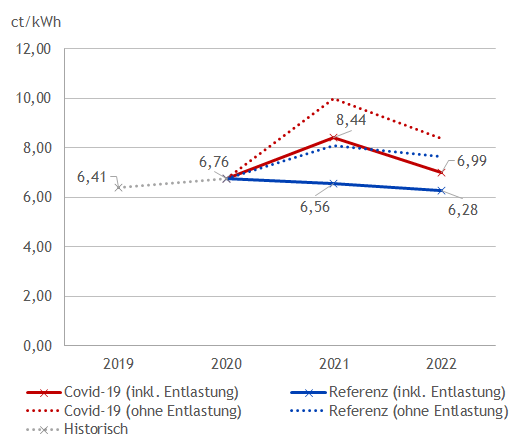
The EEG levy could rise by 25 percent next year. This is the result of an analysis conducted by the EWI on behalf of E.ON. The Analysis shows that the levy could rise to 8.44 cents per kilowatt-hour in 2021-even if the measures from the German Klimaschutzpaket are accounted for. In 2022 the EEG levy would amount to 6.99 cents per kilowatt-hour. This means that the EEG levy in 2021 is 28 percent and in 2022 11 percent above the forecast EEG levy without the Covid 19 pandemic.
EWI has analyzed two scenarios in its analysis. The counterfactual reference case describes a hypothetical world without a Covid-19 pandemic, based on the expectations of 31 December 2019. The Covid-19 scenario continues the expected real developments based on current events of the pandemic. Depending on the scenario, final energy consumption by energy source was projected using the forecasts for economic development, temperature effects and taking into account energy efficiency measures.
Based on the developments in electricity consumption and the expected development of the power plant strucutre, effects on the wholesale price for electricity are derived using the EWI Merit-Order Tool. According to this, the wholesale electricity price will fall sustainably by more than 8 euros per megawatt hour beyond 2022. “The reason for this is, on the one hand, that demand is falling sharply,” says EWI manager Johannes Wagner, who wrote the analysis together with Fabian Arnold and Samir Jeddi. “But the fall in fuel prices – especially gas – and emission certificates also play an important role.”

The decline in electricity demand and wholesale electricity prices are the reasons why the EEG levy increases in the Covid 19 scenario. It is assumed that, in addition to the reduction of the EEG levy already agreed in the German Klimaschutzpaket, additional relief from the planned national emission trading system will be implemented. It is assumed that all additional revenues from the agreed increase in the starting price (from 2021 EUR 25 instead of the previously planned EUR 10 per tonne CO2) will be used to compensate for the EEG levy. Without these two relief measures, the EEG levy would even rise to 9.99 cents per kilowatt hour in 2021 and 8.36 cents per kilowatt hour in 2022.
The change in the wholesale price and the EEG levy has a corresponding impact on the retail prices for electricity. Even if the lower wholesale electricity prices are passed to end consumers, in the Covid 19 scenario an increase in electricity prices for private household customers is expected in 2021 (+3.8% compared with the reference scenario in 2021 and +6.2% compared with 2019). In 2022, the final consumer price in the Covid-19 scenario falls again due to the decrease in the EEG levy and approaches the reference scenario (-0.6% compared to the reference scenario in 2022 and +2.0% compared to 2019).
On 3 June 2020, the German government decided to cap the EEG levy at 6.5 ct/kWh in 2021 and 6.0 ct/kWh in 2022. This effectively counteracts a price increase of 2.3 ct/kWh (+8%). The cap leads to largely constant prices for end consumers* if the lower wholesale prices for electricity are passed on to end consumers*. For the national budget, this relief would mean additional costs of around EUR 8 billion in 2021 and EUR 2 billion in 2022. The total burden on the budget, including the compensation payments from SESTA, would thus amount to about 13 billion euros in 2021 and 4 billion euros in 2022.